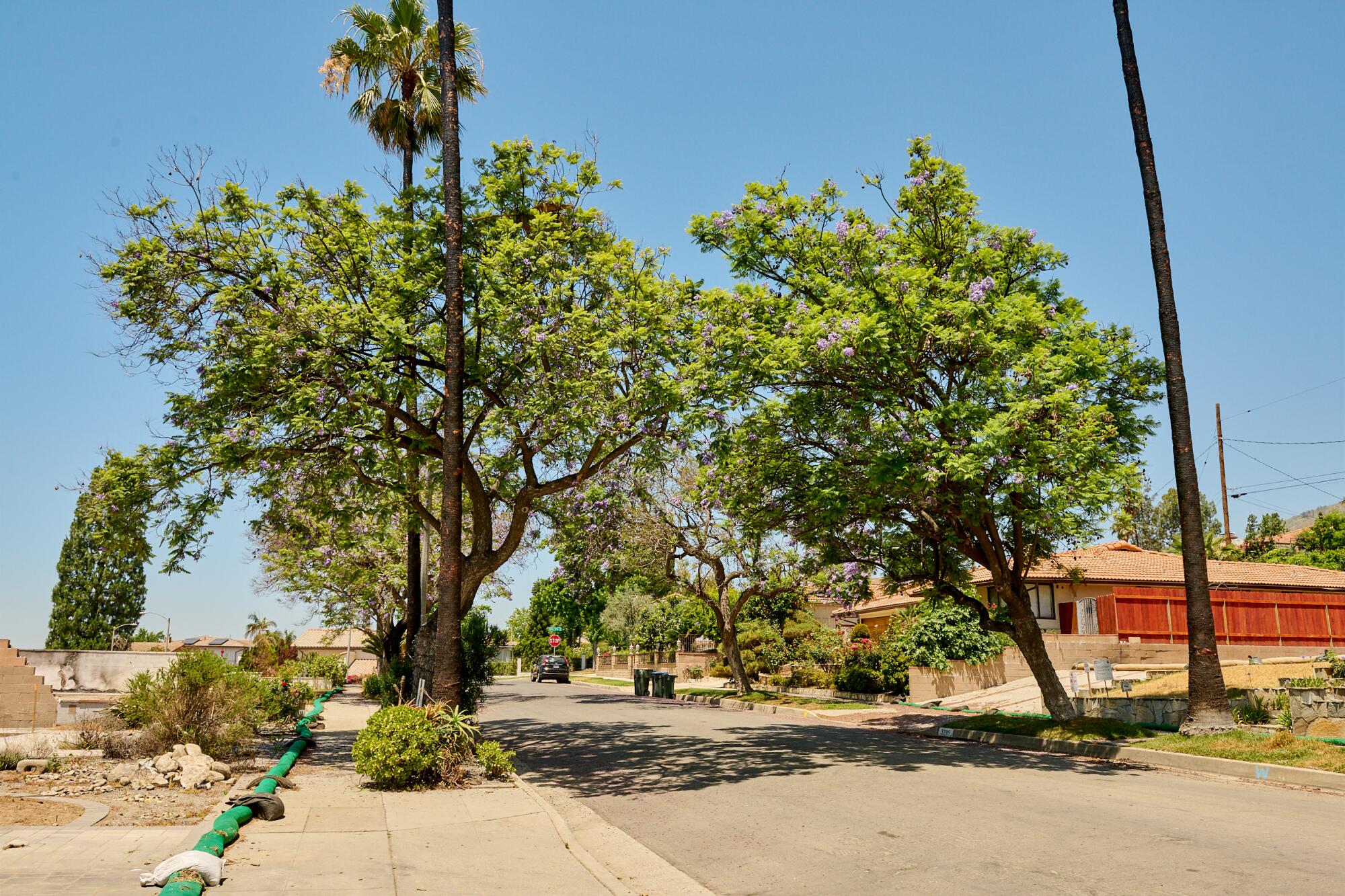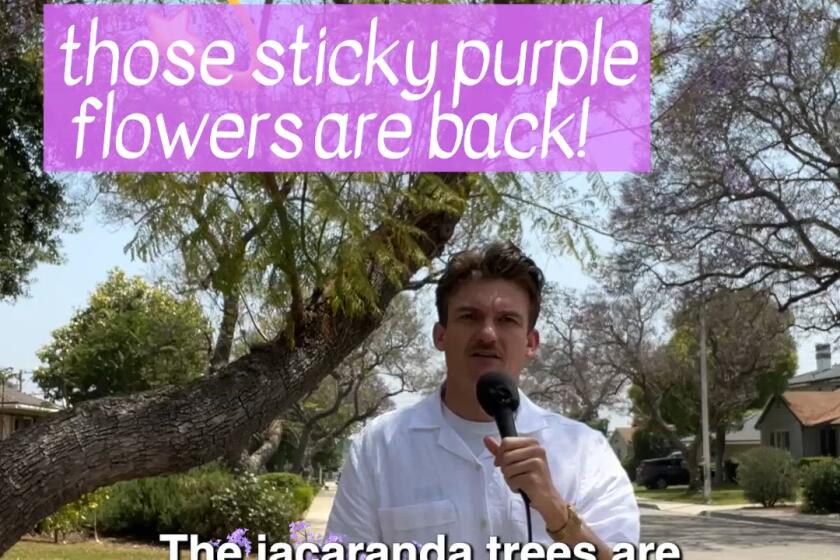
- Share via
- This year’s jacaranda bloom in L.A. was short a few trees following the January wildfires, but experts say many burned trees will recover.
- “Don’t seek perfection,” consulting arborists advised those nursing trees back to health. Just give them water and time.
It was Alexis Murphy’s tradition to photograph the jacaranda that guarded her childhood home in Pasadena. One year, she arranged its violet droppings in the shape of a heart. Another year, she turned them into a cartoon smiley face.
But this spring, after the January Eaton fire scorched her childhood home and the jacaranda along with it, the scene was too grim to capture. Where the aged tree’s limbs once exploded into violet, singed branches crisscrossed in colorless sterility like an unfinished painting.

Murphy didn’t want to post something too depressing. So she snagged a flower from a neighbor’s lawn and filmed a close-up of the blossom, panning out to her burned tree.
That was when she saw it.
Barely discernible in the May gloom, a glint of purple shone from the jacaranda’s canopy; nearby, seed pods dotted patches of green. The tree was in bloom.
“Oh, my God, maybe it is coming back,” she said, half-wishing for the tree’s revival.
Jacarandas, among the most divisive of L.A.’s imported plant species, have long signified to Angelenos the coming of warmer, more vibrant days. Their symbolic weight has been all the greater for those who lost their homes to the January wildfires that devastated L.A. County as well as swaths of its natural landscape.
“Any tree that’s leafing out or recovering is a sign of hope for everyone, and I think people really take some joy in that,” said David Card, a longtime Pacific Palisades resident and board president of the Palisades Forestry Committee.

“Right now, it’s the jacarandas that are center stage,” Card said.
The jacaranda trees have started to bloom across Southern California.
A post-fire jacaranda bloom
Originating in subtropical South America, jacarandas typically bloom around May and June, taking their cue from the season’s first stretch of consistent heat. In wetter years, the 25- to 40-foot-tall trees may not push out flowers until well into July.

This year, hot spells in May encouraged some early bloomers, said Lisa Smith, a consulting arborist and president of the tree-consulting firm the Tree Resource.
Still, at the time of the January fires, the semi-deciduous trees had not yet flowered, which likely minimized the damage they suffered.
The arborist said what also helped is that jacarandas are highly heat-tolerant and generally planted among low grasses rather than tall shrubs, limiting the potential for upward burn.
“They’re a pretty rugged, tolerant species. They can handle harsh conditions,” Smith said.
Because jacarandas across the county sustained significant bark char and crown damage, L.A.’s purple bloom was down some patches this year. The issue might worsen. Healthy-seeming flowering on trees like Murphy’s could be a “false start” belying the plant’s sickness, Smith said.
Trees have been known to experience delayed deaths years after a wildfire has been extinguished.
Stark aerial photos of the Eaton and Palisades fires show blocks of ash where houses used to be, and a surprising number of green trees. Why? Plus February plant events.

Nonetheless, researchers in Pasadena and the Pacific Palisades shared positive outlooks for the trees’ future recovery.
Gretchen North, a biology professor at Occidental College, said plant recovery efforts in the canyons above Altadena have revealed that jacarandas have fared “remarkably well.”
“They’re blooming, even though they are burned at the base,” North said. The professor added that most of the damage is limited to scorched bark. In cases of more severe scarring, North said, “the jacaranda looks like it will recover.”
In the Palisades, the trees this year began flowering far earlier than expected, said Card.
Speaking for the trees
However, experts warned that L.A.’s trees, including jacarandas, still face threats from post-fire recovery efforts.
For one, construction activities like excavation and soil compaction from heavy machinery can damage a tree’s critical root zone, preventing uptake of water and nutrients crucial for the plant’s survival.

On a wider scale, activists said joint cleanup efforts by FEMA and the U.S. Army Corps of Engineers have prompted the premature removal of trees in the Palisades, hundreds of which were misidentified by unqualified contractors.
“They were bringing in people from states so far away they never even heard of jacarandas,” said Carl Mellinger, a consulting arborist and member of the Palisades Forestry Committee.
“In my opinion, if you can’t tell what the tree is, you have no business identifying its fiber-building period,” Mellinger said.
A spokesperson for the U.S. Army Corps of Engineers said that “every decision about tree removal is made thoughtfully and with expert guidance from professional arborists.”
“While we strive to preserve as many trees as possible, public safety and recovery progress must come first,” the spokesperson said. “We continue to work closely with homeowners, the county and community groups to make informed, responsible decisions about tree removal and preservation. ”
A representative for FEMA declined to comment.
New soil testing has found high levels of lead in the soil at wildfire-destroyed homes that federal cleanup crews had determined to be cleared of such contaminants, according to Los Angeles County.
Mellinger was able to work with a colonel to get the Army Corps’ protocol changed and minimize errors, he said, “but there were still trees out there that were gonna get cut down, even though they were viable.”
Residents whose injured trees were removed were surprised to find themselves more distraught about losing the trees — which would take decades to regrow — than losing their homes.
LuAnn Haslam, Murphy’s next-door neighbor in Pasadena, said losing her jacaranda felt like a second wave of grief after her home burned down. For more than 25 years, she’d marveled at the tree, one of her favorites gracing the street. When it blossomed each spring, coating her lawn in purple blooms, she’d beg her husband, “Don’t clean those up!”
Haslam said she didn’t watch the cleanup crew remove the tree this year. She couldn’t bear it.

For more than 25 years, Pasadena resident LuAnn Haslam marveled at the jacaranda tree on her street. (Luann Haslam)

For Haslam, losing her jacaranda felt like a second wave of grief after her home burned down. (Luann Haslam)
“That’s one reason why I really pushed it on the colonel that you can’t be cutting down these trees that are going to make it,” Mellinger said.
“People have already been through one disaster,” he said. They needn’t endure another.
The Palisades Forestry Committee in March published a waiver for property owners that allowed them to retain so-called “hazardous” trees on their property. Card said the system has largely worked, save for the occasional complication by an overly aggressive contractor.
However, arborists and activists agreed that Zone 0 regulations may spell trouble for those working to preserve the Palisades’ natural landscape. The defensible space directives, meant to minimize burn risk to homes and other structures, are poised to drastically reduce the number of trees permitted in residential L.A. neighborhoods, said North.
The trick, North said, will be balancing safety assurances that cities require with the green recovery that their residents need to move forward.
The Eaton fire destroyed much of Altadena. Now, residents are fighting to save the trees that survived.
The flowers of your labor
Many factors affecting the survival potential of burned trees, including jacarandas, are out of individuals’ control: the level and frequency of rain, the pace of bark generation, the passage of time.
Still, arborists said residents can take several steps to improve their trees’ chances of recovery.
The most critical factor, Smith said, is water. Without it, scores of jacarandas won’t even make it through the summer.

“Don’t seek perfection. Just get water on the tree,” Smith said. She added that those who live far away now can ask a neighbor or friend to place a tree watering bag around the trunk of the injured tree. This way, water is slowly released, trickling down to the roots.
Smith added that if the tree is able to push out fresh leaves, residents can prune its dead branches and leave the live ones to foster “meaningful new growth in the canopy.”
A good visual cue for a salvageable tree is the growth of new bark beneath its burned outer layer, said Mellinger.
“You have to scrape the bark or cut under the bark to try and find the living tissue that’s under the cambium and the inner bark,” he said.
Removing dead bark before watering a burned tree can also protect it from pests and pathogens, said Jim Henrich, curator of living collections at Los Angeles County Arboretum & Botanic Garden.
Priority No. 1, Henrich said, is making sure water is actually saturating the soil. After that, all you can really do is wait.
The Eaton and Palisades fires likely made polluted soils worse, but soil experts say bioremediation may be an alternative to scraping, especially for gardeners.
For many jacaranda lovers, the labor of preservation was a knee-jerk reaction, like shielding a child from a blow. Valeria Serna of climate nonprofit Resilient Palisades recently purchased a 500-gallon water tank on her own dime and lugged it to several neighborhoods that lacked water access.
Vicki Warren, on the other hand, wasn’t much concerned about the fate of the jacaranda outside her late father’s home, which burned in the Palisades fire. It was the magnolia in the backyard she loved.

But when the Army Corps removed her beloved tree this year, all that remained was the jacaranda — the one that for years had left her car sticky with sap and stunk up the street.
One day in May, Warren parked in the spot on Radcliffe Avenue, which she had trained herself to avoid, right below the purple giant. Then she made a promise.
“You and I are the only ones left here,” she told the tree.
“I’m going to take care of you.”
More to Read
Sign up for The Wild
We’ll help you find the best places to hike, bike and run, as well as the perfect silent spots for meditation and yoga.
You may occasionally receive promotional content from the Los Angeles Times.
















